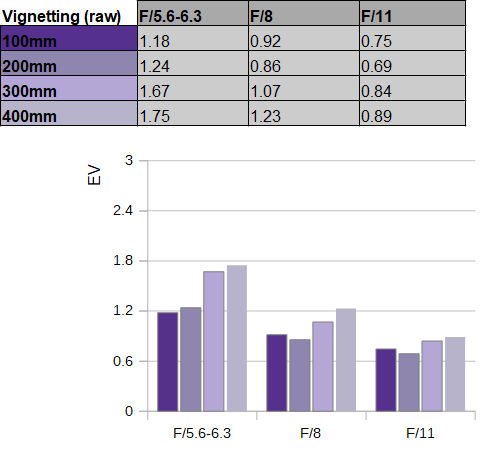|
Sigma 100-400mm f/5-6.3 DG DN OS Contemporary - Review / Test - Analysis |
|
Lens Reviews -
Sony Alpha (Full Format)
|
|
Page 2 of 3

Distortion
The Sigma 100-400mm f/5-6.3 DG DN OS Contemporary shows comparatively high, pincushion-type image distortions in RAW images. They are still quite low at 100mm but increase to medium levels from the middle range.
With activated image auto-correction, the distortions are perfectly corrected as you can see below.
Vignetting
The RAW vignetting is higher than average for a lens in this class. This is probably related to the rather small diameter of the front element. A peak of ~1.7 EV is quite visible at the longer end and maximum aperture. Stopping down reduces this, of course.
 With activated image auto-correction this is reduced to sub-0.9EV at maximum aperture. This can still be noticeable in certain scenes but it's acceptable.
With activated image auto-correction this is reduced to sub-0.9EV at maximum aperture. This can still be noticeable in certain scenes but it's acceptable.

MTF (resolution)
The Sigma lens produced decent resolution figures in the MTF lab. The peak performance isn't up there with the best but it's commendable nonetheless. At 100mm the center quality is very good to excellent at f/5 and the outer image field is easily on a good level. The center quality doesn't improve when stopping down but there's a slight gain in quality at the image borders. The best quality is reached in the middle part of the zoom range with very good results across the image field at f/6.3 and f/8. Unsurprisingly, there's a drop in quality at 400mm. The center performance remains high at f/6.3 and the borders are still good but the corners fall behind. Stopping down improves the broader center zone.
The field curvature is low. The centering quality of the tested sample was good overall.
Please note that the MTF results are not directly comparable across the different systems!
Below is a simplified summary of the formal findings. The chart shows line widths per picture height (LW/PH) which can be taken as a measure for sharpness.
If you want to know more about the MTF50 figures you may check out the corresponding Imatest Explanations

Chromatic Aberrations (CAs)
Lateral CAs (color shadows at the image borders) are very low in the low to mid-range. They increase slightly at 400mm but remain unobtrusive. Lateral CAs can be auto-corrected without any relevant loss in image quality anyway.

Bokeh
The Sigma 100-400mm f/5-6.3 DG DN OS Contemporary may not be the fastest lens around but thanks to its long focal length, it's still capable of producing a shallow depth-of-field in many scenes - thus the quality of the out of focus blur (bokeh) remains an important criterion.
Out-of-focus highlights are comparatively nicely rendered with a fairly clean inner zone. There's a bit of outlining at the edge of the discs which is emphasized the more you stop down. The circular disc shape is maintained at the maximum aperture as well as f/8 with minor traces of the more edgy aperture showing up at f/11.
 The following samples illustrate the highlight rendering across the image field (taken around 135mm here). Circular highlights are maintained in a fairly broad central zone before deteriorating towards the borders and corners. Stopping down broadens the "good" zone at f/8 and, more so, at f/11.
The general rendition in the focus transition zones isn't perfect but still good for this kind of lens. You may notice that the background blur (shown to the left below) isn't symmetrical at harsh contrasts but it is quite smooth. The rendering in the foreground is slightly harsher with a more distinct "shadow".
The following samples illustrate the highlight rendering across the image field (taken around 135mm here). Circular highlights are maintained in a fairly broad central zone before deteriorating towards the borders and corners. Stopping down broadens the "good" zone at f/8 and, more so, at f/11.
The general rendition in the focus transition zones isn't perfect but still good for this kind of lens. You may notice that the background blur (shown to the left below) isn't symmetrical at harsh contrasts but it is quite smooth. The rendering in the foreground is slightly harsher with a more distinct "shadow".

|